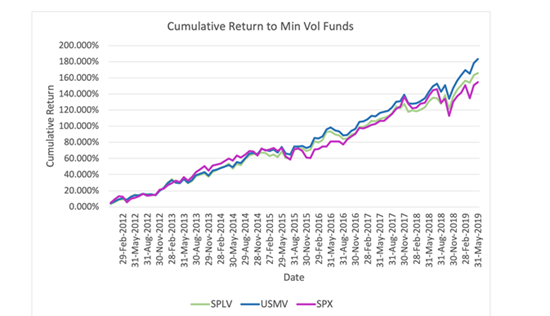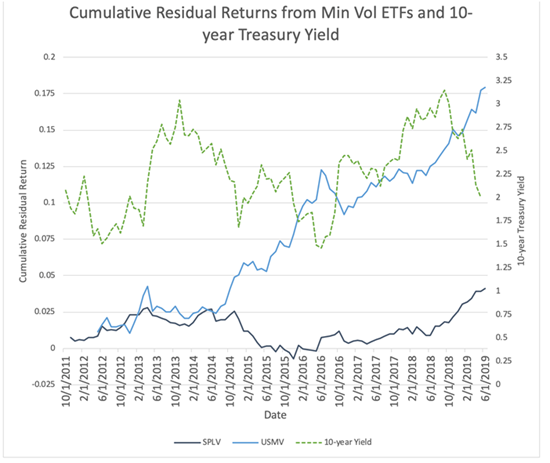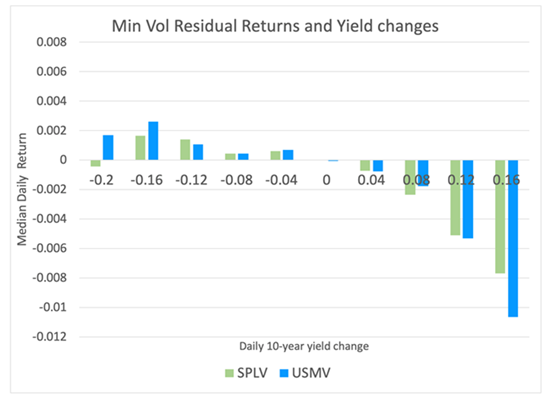Min Vol: Potential Downside To This “Safety Trade”
Minimum volatility strategies are having a scorching run in 2019. This year min volatility funds are boasting outperformance above the benchmark in a largely bull market, with IShares Min Vol ETF (USMV) gaining 22% against S&P 500’s 19%. These figures may come across as surprising. Min vol, or selecting equities with low volatility relative to the market, is typically pitched as safety trade with better downside protection, but less upside potential.
In fact, beating the benchmark has been rather common for these funds since their inception, seen in the graph below. The strong performance of min vol appears to challenge decades of financial theory. In the simplest sense, an investor should be rewarded with higher returns when bearing greater risk. The min vol phenomenon implies this notion is inconsistent.
If the rewards of min volatility are not a result of bearing market risk, where are they coming from? Low volatility stocks are characterized as defensive investments, meant to buffer during bear markets. However, this analysis is an oversimplification of deeper economic factors which are responsible for a stock’s underlying volatility.
Figure 1

Low volatility stocks are generally compromised of profitable, dividend paying companies with low growth prospects. They are made up of defensive sectors such as utilities, consumers staples, and real estate. All these features reduce cash flow uncertainty, causing these stocks to act as bond proxies, making rates the smoking gun behind min vol performance.
It is no surprise that min vol is having a great run this year because bonds are having a great run. Ten-year yields have fallen from 2.7% to near 2% since the start of July in the wake of uncertainty regarding global growth and Federal Reserve willingness to cut target rates.
Analyzing a simple correlation between treasury yield changes and returns on the min vol portfolio blurs the relationship. Since its inception, the contemporaneous correlation between USMV and yield changes is 0.2, implying min vol returns respond positively to yield increases. This result is due to the exposure of the min vol portfolio to broader market movements, not purely interest rate risk. Extracting the residual return from the simple market model using the S&P 500 (below) provides a cleaner picture of the influence of rates on min vol.[1]

The residual component (ϵt) represents returns not attributed to market fluctuations. Now, when correlation is calculated on the USMV residual returns and yield changes, negative at -0.32. This is consistent with the bond-like behavior of min vol; returns respond negatively to increases in yield. The cumulative residual return for USMV, the S&P Low Volatility ETF (SPLV) are presented along with the 10-year yield in the graph below. SPLV is comprised of the low volatility stocks restricted to be constituents of the S&P 500.
Figure 2

There are two valuable observations that can be extracted from this graph. First, it displays the depressed performance of min vol during heightened rate environments. This is clear during the second half of 2013 in response the bond market taper tantrum, and during 2017 in which the Fed hiked rates three times.
Second, there is a substantial divergence in cumulative residual returns between USMV and SPLV beginning in 2015. This is a result of a larger beta associated with SPLV, which reduces the size of the residual. SPLV’s higher correlation with the SPX leads to a lower sensitivity for returns in response to yield changes. This higher rate exposure plays a role in the stronger performance of USMV relative to SPLV.
The following graph displays median residual returns of the funds sorted into buckets based on the daily change in the 10-year yield at beginning at fund inception. The inverse relationship is evident - min vol funds respond negatively to increases in yield. However, an important subtle implication of the chart is the asymmetry in returns for positive versus negative yield changes. Increases in yield have a much larger influence on residuals than a decrease of a similar size. For example, a decrease in yield ranging
from -0.121 to -0.16 has median residual of 0.26%, whereas the downside doubles for the opposite positive bin (0.121 to 0.16) at -0.53%. In a scenario where rates rise rapidly, the potential downside to min vol is substantial.
Figure 3

Minimum volatility is more than a safety trade. This analysis demonstrates that the strategy has significant exposure to interest rates. Since their inception, min vol funds have benefitted from a decade of lax monetary policy and record low yields. This paradigm is unlikely to change soon, as the Fed has signaled its intention to cut rates in the face of slowing economic growth. However, should rates enter a higher, more volatile regime there will be plenty of risk in min vol portfolios to go around.
**********
Garrett DeSimone, PhD, is Head of Quantitative Research at OptionMetrics
Footnotes
- [1] Regressions are calculated using daily returns of a 120 day rolling windows. This allows for the beta exposure to vary throughout time.
***
The views expressed in this article are those of the author and do not necessarily reflect the views of AlphaWeek or its publisher, The Sortino Group
© The Sortino Group Ltd
All Rights Reserved. No part of this publication may be reproduced, stored in a retrieval system or transmitted in any form or by any means, electronic, mechanical, photocopying, recording or scanning or otherwise, except under the terms of the Copyright, Designs and Patents Act 1988 or under the terms of a licence issued by the Copyright Licensing Agency or other Reprographic Rights Organisation, without the written permission of the publisher. For more information about reprints from AlphaWeek, click here.







